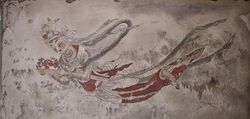Unsolved:Tennin
They originated in Hinduism as "Apsara" (Sanskrit: अप्सरा, romanized: apsaras or apsarā); a member of a class of celestial beings in Hindu and Buddhist culture. They are originally a type of female spirit of the clouds and waters, who later plays the role of a "nymph" or "fairy". They figure prominently in the sculpture, dance, literature and painting of many Indian and Southeast Asian cultures. In Japan, Apsara are known as Tenshi "(天使)
Tenshi Tennin" (天人); "Tennyo" (天女) for "female Tennin" and "Tennan" (天男) for "male Tennin".
History
Tennin are mentioned in Buddhist sutras,[citation needed] and these descriptions form the basis for depictions of the beings in Japanese art, sculpture, and theater. They are usually pictured as unnaturally beautiful women dressed in ornate, colourful kimono (traditionally in five colours), exquisite jewelry, and stole-like, feathered, flowing scarves--called both Tenne (纏衣, lit. a "Wrapping Raiment" or "Heavenly Raiment") and Hagoromo (羽衣, lit. 'Feather[ed] Raiment')--that wrap loosely around their bodies (a parallel to the Christian Halo), as-well-as Gokō (後光, let. 'back[ground] light' or 'aureole'; an actual halo). They usually carry lotus blossoms as a symbol of enlightenment or play musical instruments such as the biwa, or flute.[1][2]
Religion
Tennin are believed to live in the Buddhist heaven as the companions to the Buddhas and Bodhisattvas. Some legends[citation needed] also make certain tennin solitary creatures living on mountain peaks. Pilgrims sometimes climb these mountains in order to meet the holy spirits.
Powers
Tennin can fly, a fact generally indicated in art by their coloured or feathered kimono, called both Tenne (纏衣, lit. a "Wrapping Raiment" or "Heavenly Raiment") and Hagoromo (羽衣, lit. 'Feather[ed] Raiment').[citation needed] In some legends, tennin are unable to fly without these kimono (and thus cannot return to heaven).[3] More rarely, they are shown with feathered wings.[1] In a Noh play Hagoromo, which bears a number of similarities to the Western swan maiden legends,[4] tennyo come to the earth and take off their hagoromo. A fisherman spies them and hides their clothes in order to force one to marry him. After some years he tells his wife what he did, and she finds her clothes and returns to heaven.[3] The legend says it occurred on the beach of Miho no Matsubara, now a part of the city of Shizuoka.
See also
- Apsara
- Ceres, Celestial Legend
- Divine being
- InuYasha Movie 2: Castle Beyond the Looking Glass
- List of angels in theology
- Nymph
- Selkie (seal maidens)
- Swan maiden
- Valkyries
- Feather cloak
References
- ↑ 1.0 1.1 Tennin at GODS of Japan, A-to-Z Photo Dictionary of Japanese Buddhism (Buddhist & Shinto Deities)
- ↑ Hearn, Lafcadio, Glimpses of an Unfamiliar Japan at Project Gutenberg online book catalog
- ↑ 3.0 3.1 Waley, Arthur (1921), The Noh Plays of Japan, Chapter V, p. 177, "A Note on Hagoromo"
- ↑ The Legend of Connor O'Quin and the Swan Maiden at Folklore of the Burren
External links
 |


